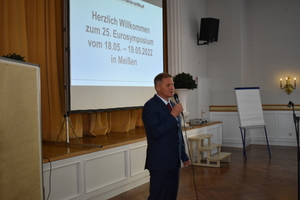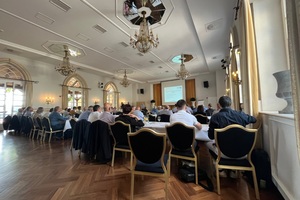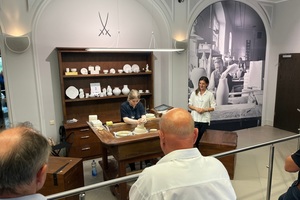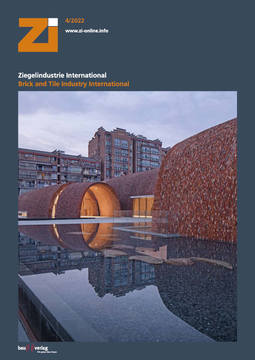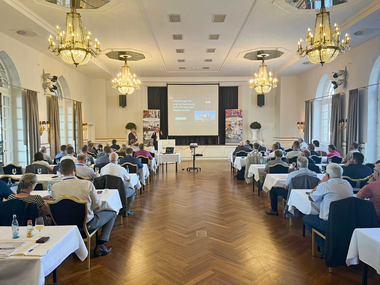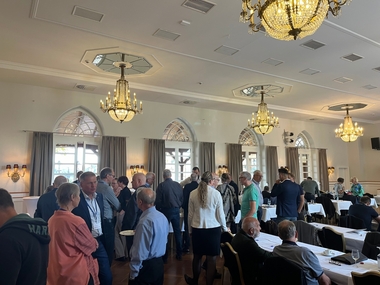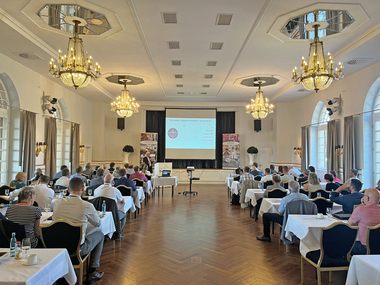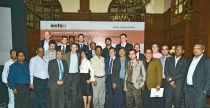25th Eurosymposium: Ceramic expertise for the future
More than 60 experts from the entire ceramics sector met again on 18 and 19 May 2022 for the 25th Eurosymposium in Meissen in Germany. The joy among participants and organisers was great, because the event had to be cancelled in the past two years due to corona.
Programme of the
first day
In his opening address, Managing Director Dr Jens Petzold pointed out to the participants the importance of exchanging ceramic expertise for the future development of technology and the economy.
In his welcoming address, the Lord Mayor of Meißen, Olaf Raschke, reminded the participants of the close ties that have existed for hundreds of years between the city of Meißen and the ceramic industry and research.
The first technical lecture, given by Annet Hümmer, Stephan Schmidt KG, dealt with raw materials and sustainability in the ceramics industry. She addressed the contribution of raw material suppliers as well as raw material users to the promotion of sustainability.
Mathias Koza, Sunfire GmbH, presented the electrolysis process with which his company produces green hydrogen and green synthesis gas, and gave an outlook on the potentials and hurdles in the series production of electrolysers.
In the last technical lecture of the first day, Dr Volkmar Lankau, CeraFib GmbH, presented oxide ceramic fibre composites. Thanks to integrated ceramic fibres, they exhibit significantly higher resistance to mechanical and thermal stresses. This allows applications that are not possible with monolithic materials.
Following the lectures, the traditional evening programme of the first day of the symposium took the participants to Europe’s oldest porcelain manufactory, the Staatliche Porzellan-Manufaktur Meißen. In addition to a guided tour of the show workshop, the visitors took a look at the exhibition on the “Richard Bampi Prize 2022” and the museum exhibition. At the end of the day, the participants enjoyed dinner and a view over the roofs of the city.
Programme of the
second day
The programme of the second day was initiated by Dr. Horst Schmidt, Alferrock GmbH, with a lecture on a new raw material based on red mud, a residual material from the aluminium industry. High density and heat capacity allow its use for ceramic high-temperature heat storage. Particularly suitable fields of application are the conversion of electricity into heat and electricity storage.
Dr Thomas Wolff, Dinex Deutschland GmbH, reported on the development of a new SiC substrate for use as a filter substrate for diesel particulate filters. Due to the high thermal shock stability and special small pores, very efficient and durable filters can be produced with it.
Daniel Hipp, ONEJOON GmbH, explained how the thermal energy demand of kiln plants can be significantly reduced by taking into account the flow control of the firing processes as well as the highest possible ratio of product to kiln furniture. With the pusher plate kiln based on these concepts, significant performance increases and thermal energy savings have been achieved.
Mathias Wilde, Ceramaret GmbH Meißen, devoted himself to the development of technical ceramics at the Meißen site. He took the participants through the history of the ceramics industry in Meißen and the special areas of application of technical ceramics.
In the last lecture, Dr Jens Petzold explained the hurdles involved in converting firing to electrical energy. He presented technical solutions in kiln construction and process engineering that can already be implemented and are also used outside Europe. In Germany, he said, the main obstacle is the lack of available cheap and CO2-neutral energy.
In his closing speech, Dr Petzold thanked the participants and invited them to the next Eurosymposium on 6 and 7 September 2023.

